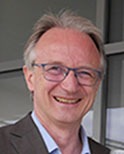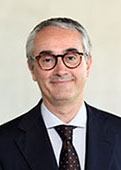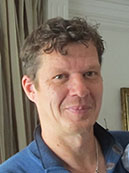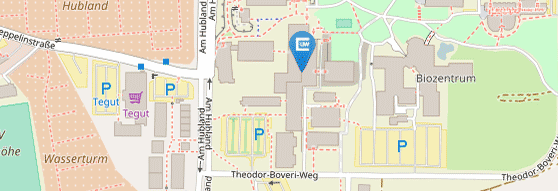Functional Pi- Systems - Organic Materials Design by Molecular and Supramolecular Engineering

Organization: Prof. Dr. Frank Würthner (JMU Würzburg, Center for Nanosystems Chemistry)
Dr. Florian Beuerle (JMU Würzburg, Center for Nanosystems Chemistry)
Rachel Steinhaus (JMU Würzburg, Faculty of Chemistry and Pharmacy)
Dates: July 19th - 23rd, 2021
Application Deadline: April 1, 2021
Place: Webinar by the Center for Nanosystems Chemistry of the JMU Würzburg
Level: Master Class for Chemistry Students with at least a Bachelor’s degree in Chemistry (or related field)
Students can receive a participation certificate upon completion of the course with a list of the total work load and competencies. Please check with your home institution if this can be recognized for credit.
Course Outline:
Conjugated pi-systems are a most important class of materials that are utilized in a large variety of applications such as colorants or as functional materials, e.g. as organic semiconductors, as emitters in OLEDs, or in photodetectors or photovoltaic devices. Different from traditional colorant research, the properties of these functional materials are governed extensively by intermolecular interactions, thereby entailing significant limitations to the classical approach based on molecular structure – molecular property (color, emission, redox properties) relationships for the respective dye molecules. Accordingly, for a rational design of molecular materials for these applications, researchers need to understand both molecular properties as well as the impact of packing arrangements. In this course, the attendees will acquire the fundamental knowledge for successful research in the area of functional pi-systems. Our course will start by providing insight into the structure – absorption/emission/redox property relationships for dye molecules and continue with insights onto the impact of packing arrangements in dye aggregates on these properties. Further, we will discuss important pi-systems utilized in the wider area of organic electronics and elaborate how their packing arrangement in the solid state influences functional properties such as charge carrier transport, absorption and emission. At the last day, the teachers of this course will present some highlights of their current research including applications in organic light emitting devices, photodiodes and solar cells.

Frank Würthner received his education at the University of Stuttgart, Germany (doctoral degree in 1994). After positions at MIT, BASF central research and the University of Ulm, he became full professor of Organic Chemistry at the University of Würzburg in 2002. Since 2010 he is also the founding director of the Center for Nanosystems Chemistry in Würzburg. He has published more than 500 papers on functional dyes, dye aggregates, artificial photosynthesis, and on organic semiconductors for applications in electronics, photonics and photovoltaics. Since 2014 he is listed as a highly cited chemist. He is an elected member of the German National Academy of Science Leopoldina and the Bavarian Academy of Sciences, as well as a Fellow of the Royal Society of Chemistry. His awards include the Arnold-Sommerfeld-Prize, the Elhuyar-Goldschmidt Award, the Ta-Shue Chou Award and the Adolf-von-Baeyer Medal.
The following review articles are related to the topics addressed in this course:
F. Würthner
Acc. Chem. Res. 2016, 49, 868–876
Dipole-Dipole Interaction Driven Self-Assembly of Merocyanine Dyes: From Dimers to Nanoscale Objects and Supramolecular Materials
F. Würthner, C. R. Saha-Möller, B. Fimmel, S. Ogi, P. Leowanawat, D. Schmidt
Chem. Rev. 2016, 116, 962–1052
Perylene Bisimide Dye Assemblies as Archetype Functional Supramolecular Materials
M. Gsänger, D. Bialas, L. Huang, M. Stolte, F. Würthner
Adv. Mater. 2016, 28, 3615–3645
Organic Semiconductors based on Dyes and Color Pigments
D. Bialas, E. Kirchner, M. I. S. Röhr, F. Würthner
J. Am. Chem. Soc. 2021, in press
Perspectives in Dye Chemistry: A Rational Approach toward Functional Materials by Understanding the Aggregate State

Christoph Lambert is full professor of Physical Organic Chemistry at the University of Würzburg. After studying chemistry at Erlangen/Germany (PhD 1993 with Paul v. R. Schleyer) he moved to Cambridge/UK for a postdoctoral stay and then back to Germany in 1994 to the University of Regensburg where he obtained his venia legendi in 1998. Since 1999 he is at Würzburg, working on redox properties of functional dyes (organic mixed valence compounds), dye oligomers and polymers, and on donor acceptor compounds. The focus of the scientific work is on light induced dynamics (energy and electron transfer) probed by time resolved fluorescence and transient absorption spectroscopy, also applying magnetic fields to investigate the involved spin chemistry, and on nonlinear optics such as two-photon absorption processes.
The following articles are related to the topics addressed in this course:
A. Heckmann, C. Lambert
Angew. Chem. Int. Ed. 2012, 51, 326-392.
Organic Mixed‐Valence Compounds: A Playground for Electrons and Holes
M. H. Schreck, M. I. S. Röhr, T. Clark, V. Stepanenko, F. Würthner, C. Lambert
Chem. Eur. J. 2019, 25, 2831-2839.
A Self-Assembled Unit Comprising 12 Squaraine Dyes Built up from two Star-Shaped Hexasquarainyl-Benzene Molecules
M. I. S. Röhr, H. Marciniak, J. Hoche, M. H. Schreck, H. Ceymann, R. Mitric, C. Lambert
J. Phys. Chem. C 2018, 122, 8082-8093.
Exciton Dynamics from Strong to Weak Coupling Limit Illustrated on a Series of Squaraine Dimers
T. Brixner, R. Hildner, J. Köhler, C. Lambert, F. Würthner
Adv. Energy Mater. 2017, 7, 1700236
Exciton Transport in Molecular Aggregates, From Natural Antennas to Synthetic Chromophore Systems

Johannes Gierschner received his Ph.D. in Physical Chemistry in Tübingen, Germany in 2000. After stays in Tübingen, Mons, and at Georgia Tech, Atlanta, he joined IMDEA Nanoscience in 2008 as a Senior Research Professor (Ramón y Cajal fellow 2008-13). In 2014 he habilitated at the University of Tübingen and holds an Adjunct Professor position there in Physical Chemistry since then.
Currently, he is regular visiting researcher at Seoul National University and University of Valencia. His 140 papers integrate optical spectroscopy and computational chemistry to elucidate structure-property relationships in conjugated organic materials.
The following review articles are related to the topics addressed in this course:
J. Gierschner, J. Shi, D. Roca-Sanjuán, B. Milián-Medina, S. Varghese, S. Y. Park Adv. Opt. Mater. 2021, under revision. Luminescence in Crystalline Organic Materials: From Molecules to Molecular Solids S. K. Behera, S. Y. Park, J. Gierschner Angew. Chem. Int. Ed. 2021, accepted. Dual Emission: Classes, Mechanisms and Conditions J. Gierschner, S. Varghese, S. Y. Park Adv. Opt. Mater. 2016, 4, 348–364. Organic Single Crystal Lasers - a Materials View J. Gierschner, S. Y. Park J. Mater. Chem. C 2013, 1, 5818–5832. Luminescent Distyrylbenzenes: Tailoring Molecular Structure and Crystalline Morphology J. Gierschner, L. Lüer, B. Milián-Medina, D. Oelkrug, H.-J. Egelhaaf J. Phys. Chem. Lett. 2013, 4, 2686-2697. Highly Emissive H-Aggregates or Aggregation-Induced Emission Quenching? The Photophysics of All-Trans Para-Distyrylbenzene
Dyes: Fundamentals (2h; Würthner): Structure of important dyes and pigments; Light-Matter Interaction; UV/Vis spectrum, selection rules, transition dipole moment, vibronic coupling, solvent effects; Types of chromophores, Hückel MO
Molecular Luminescence (2h; Gierschner): Excited state deactivation (Jablonski term scheme), internal conversion (energy gap law, Kasha's rule, conical intersections, environmental effects), fluorescence (Einstein equations, Strickler-Berg, spontaneous vs. induced processes, non-Kasha, thermal activation, dual emission), inter-system processes (ISC, phosphorescence, triplet recycling), quenching, photochemistry
Molecular Redox Systems (2h, Lambert): experimental techniques (cyclic voltammetry, square wave voltammetry,…), determination of redox potentials, multiredox systems, radical cations/anions, polarons, mixed valence compounds
Dye Aggregates (4h; Würthner): pi-pi-stacking (theoretical methods, energy decomposition analysis); structural methods, X-ray diffraction, packing arrangements, polymorphism, microscopic methods, MS and NMR, optical spectroscopy (UV/Vis, CD), molecular exciton model (Kasha),, self-assembly models (isodesmic, cooperative, anticooperative), solvent-dependent binding strength, Kinetic control, living supramolecular polymerizations, supramolecular block copolymers
Organic Semiconductors (3h, Lambert): band vs hopping transport; Fermi level; small molecules and polymers; polarons; excitons; band gap; cyclic voltammetry; UPS; conductivity measurements, charge carrier mobility determination; organic semiconductor materials, polyacetylene, MEH-PPV, P3HT, PEDOT, PANI, acenes, copper phthalocyanine; PTCDA and perylene bisimides; triarylamines; oligothiophenes; organic photoconductors, OFETs, OLEDs, organic solar cells.
Luminescent Molecular Solids (3h; Gierschner): bimolecular deactivation processes (annihilation, fission, energy transfer, photoinduced electron transfer), weakly interacting 3D systems (exciton migration, fluorescence polarization), solid state arrangements (classification, polymorphism), spectral shifts, radiative decay in molecular excitons, excitons vs. excimers, solid state luminescence enhancement, non-radiative deactivation, exciton trapping & sensitization, luminescent solid state systems (luminescent single crystals and polycrystals, co-crystals, stimuli-responsive materials, luminescent molecular liquids and liquid crystals)
Click here to view the course schedule.
All presentation slides will be made available in pdf form. Participants will recieve information on accessing these files closer to the course dates.
There will, however, be no recordings of the lectures themselves nor are you allowed to record the sessions yourself.
Further information such as meeting links will be made available closer to the course dates.
All students will be offered a scholarship which covers the full cost of participation in this course. Please return your signed Declaration of Acceptance of Scholarship form as part of your application to confirm your scholarship. The scholarship will be directly applied to your participation fees - you will not receive a bill nor the scholarship funds.
Plesae note the English version of the Declaration of Accpetance of Scholarship is intended solely as a convenience to non-German-reading applicants. Any discrepancies or differences that may arise in the translation of the German version are not legally binding.
The application deadline for this Virtual Chemistry Course has passed. All seats are filled, so no late registration will be possible.

